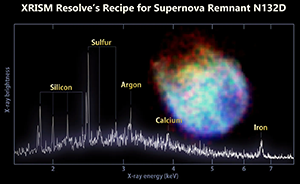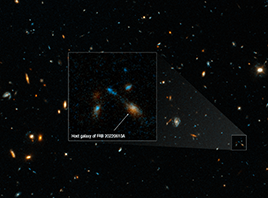| NASA / JAXA XRISM Mission Reveals Its First Look at X‑ray Cosmos | |
|---|---|
 |
The Japan-led XRISM (X-ray Imaging and Spectroscopy Mission) observatory has released a first look at the unprecedented data it will collect when science operations begin later this year. Read more » |
| NASA’s Webb Finds Signs of Possible Aurorae on Isolated Brown Dwarf | |
|---|---|
 Artist Concept Brown Dwarf W1935. |
Astronomers using NASA’s James Webb Space Telescope have found a brown dwarf (an object more massive than Jupiter but smaller than a star) with infrared emission from methane, likely due to energy in its upper atmosphere. This is an unexpected discovery because the brown dwarf, W1935, is cold and lacks a host star. Read more » |
| Hubble Finds Weird Home of Farthest Fast Radio Burst | |
|---|---|
 A NASA Hubble Space Telescope image of the host galaxy of an exceptionally powerful fast radio burst, FRB 20220610A. |
Astronomers using NASA's Hubble Space Telescope have found a rare event in an oddball place. It's called a fast radio burst (FRB), a fleeting blast of energy that can — for a few milliseconds — outshine an entire galaxy. Hundreds of FRBs have been detected over the past few years. They pop off all over the sky like camera flashes at a stadium event, but the sources behind these intense bursts of radiation remain uncertain. Read more » |
| NASA’s Webb Discovers Dusty ‘Cat’s Tail’ in Beta Pictoris System | |
|---|---|
 This image from Webb’s MIRI (Mid-Infrared Instrument) shows the star system Beta Pictoris. |
Beta Pictoris, a young planetary system located just 63 light-years away, continues to intrigue scientists even after decades of in-depth study. It possesses the first dust disk imaged around another star — a disk of debris produced by collisions between asteroids, comets, and planetesimals. . . . Now, a team of astronomers using NASA’s James Webb Space Telescope to image the Beta Pictoris system (Beta Pic) has discovered a new, previously unseen structure. Read more » |